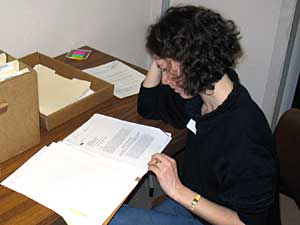February 22, 2005
 |
| Sasha Aslanian, a producer with American RadioWorks, reviews some of the documents related to PFOS/PFOA contamination and research. (MPR Photo/Mike Edgerly) |
St. Paul, Minn. — This story came about as a result of two tips. The first came from a toxicologist I met at an international conference while pursuing another environmental story. This California EPA scientist said, "When you're done with this, the one you really should do is about PFOS/PFOA." The fact that the chemicals were developed in my home state sparked my curiosity.
At this same conference, a Swedish scientist who is legendary for his work on emerging contaminants asked if I knew a researcher at the Minnesota Pollution Control Agency by the name of Dr. Fardin Oliaei. I had never heard of her, so I looked her up when I got back. As Dr. Oliaei began telling me what she knew about PFOA and PFOS, I realized this was not only a scientific story of significant local interest, but also a story about agency politics.
I enlisted the help of Mike Edgerly, our deputy news director, who's edited the environmental beat for years. Before he came to MPR in 1991, Mike reported on landfills and related problems in his native Kentucky. Early on, Mike remarked that this was ultimately a story about environmental data -- what was missing and why.
Mike and I set out to record interviews with more than 25 people -- scientists familiar with the chemicals, 3M officials, staff, managers and the commissioner of the Minnesota Pollution Control Agency, lawmakers, EPA officials and scientists, legislators and Washington County residents.
While not everyone is quoted in the final report, the information and reports they provided contributed greatly to our understanding of the story.
A spelling error led to one lucky break. I was searching for information about MPCA Commissioner Sheryl Corrigan's career at 3M. I couldn't find any mention of her on the company's Web site. When I Googled her, I accidentally put in "Cheryl" with a "C." This uncovered the minutes from a 1998 Cottage Grove City Council meeting, in which her name was also spelled with a "C." Corrigan answered residents' pollution questions at that meeting.
I ordered the video from the cable access station. This scene was key to connecting the characters in the story, and showing how the issue has evolved over time.
3M was very cooperative, and in fact, approached MPR after word reached the company about an inquiry we'd made in the Cottage Grove area. A spokesman called, offered top people for interviews and fielded many follow-up calls for fact-checking.
The MPCA gave us access to 10 different people, some multiple times. We spent two days going through agency files. Ultimately, we decided to submit a data practices request to ensure that we had seen all agency communications about these chemicals since 2000.
People we talked with who live near the 3M Cottage Grove plant or nearby landfills seem to believe that the company addressed the problem of its Scotchgard chemicals pretty responsibly.
Many interviewees placed more blame on the government, saying that those charged with safeguarding Minnesota's environment did not appear very aggressive. It seems people don't necessarily expect a corporation to look out for them, but they do expect their government to be paying attention.
A couple of times I wondered why no one had ever connected the dots on this story before. There have been stories on the chemicals, or the lawsuit, but nothing comprehensive, tying the local production and federal investigation together.
One of the Cottage Grove residents we interviewed said he had called the media years ago, urging them to report on this story. He said, "I called you people, too, and you weren't interested." Mike told him, "Well, look, we showed up!"
MPR made a substantial investment in the story, putting two of us on it virtually full time for three months.
This is a highly charged story. There are scientists and residents who fervently believe that these chemicals need to be investigated in our area. 3M and the MPCA are moving in that direction, but we questioned repeatedly why it has taken this long.
What I hope comes through in the story is that in the absence of good environmental data and thorough studies of health effects on adults and children, no one can rule out a health risk to people living near the plant or landfills.
Minnesota Public Radio will continue to follow this story and report on the environmental data once it's been gathered.




